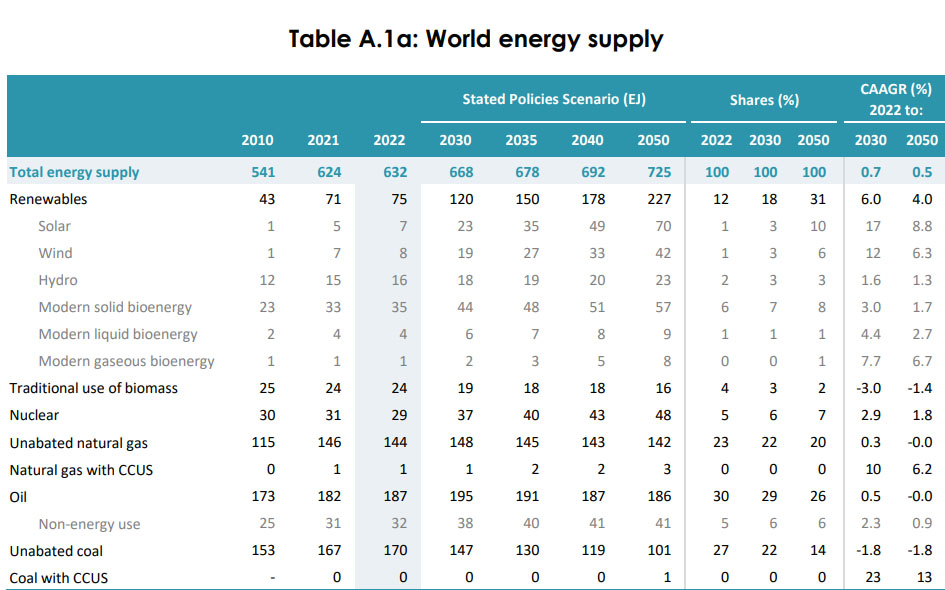Science
Related: About this forumThe 2023 World Energy Outlook Has Been Released. 632 EJ, 15 EJ from Solar and Wind in 2022.
If you want to know why the planet was on fire in the Northern Hemisphere Summer This Year, it may be useful to look at the following table, Table A.1a on Page 264 of the 2023 World Energy Outlook published by the International Energy Agency (IEA).

As usual, the tables contain the usual soothsaying of the type that predicted energy nirvanas "by 1990," "by 2000," "by 2010," and "by 2020," heavily reliant on investment in so called "renewable energy."
The new "nirvana" is in qualified terms which now says that dangerous fossil fuel energy use will peak "by 2030," which is not to say that they will be as low as, say, 2022, only that soothsaying says they'll stop growing.
Solar and wind combined grew as fast as coal, by three Exajoules, except that combined solar and wind produced 15 Exajoules in 2022, whereas coal use rose to 170 Exajoules. In "percent talk," so often utilized to obscure the uselessness of the solar and wind industry in addressing climate change, coal produced 1133% as much primary energy as solar and wind.
The consumption of petroleum rose by 5 Exajoules from 2021 to 2022 to 187 Exajoules, 167% as fast as solar and wind in "percent talk."
Overall, world energy demand rose from 624 Exajoules to 632 Exajoules, by 8 Exajoules if one has not joined Greenpeace and can thus do simple math. In "percent talk," world energy demand grew 267% faster than solar and wind.
The reactionary "solar and wind will save us" fantasy was never, of course, about attacking fossil fuels, but was rather about attacking nuclear energy, which was alleged to grow "too slow" in comparison to solar and wind, although all the trillions of dollars that have been squandered on solar and wind and which will be squandered on solar and wind have not caused it to grow to the levels nuclear energy, its growth stopped in its tracks by appeals to fear and ignorance, reached in less than 25 years in the late 20th century, around 30 Exajoules.
We can lie to each other and to ourselves, but numbers don't lie. There is no evidence, none, that so called "renewable energy" will eliminate the use of dangerous fossil fuels.
And still we chant on, throwing good money after bad.
The IEA seems to be slowly coming to face reality. A new feature of the reports includes a discussion of critical metals, metals that will be needed to be mined, tearing the shit out of the planet for eternity, to make what is called in oxymoronic doublespeak, "clean energy."
The IEA soothsaying predicts that "by 2050" the nuclear energy output will rise to 48 EJ. If the rise in the use of nuclear energy proves to be that small, not much of the planet will be left to save.
As for the rosy scenarios in the soothsaying about biomass, the IEA seems not to have noticed that much of the world's biomass is burning in place where it grows, and that agriculture itself is badly threatened by extreme weather, droughts alternating with floods.
I trust you're having a pleasant Sunday.
cachukis
(3,595 posts)progree
(12,664 posts)Last edited Mon Oct 30, 2023, 06:22 AM - Edit history (2)
by 2050
I did a little math exercise to see how much the WEO's "stated policies" scenario (shown in the above table) would reduce fossil fuel use by 2050, the last year in the table.
Fossil fuel supply from IEA WEO 2023.
2022 and 2050 under stated policies scenario, ExaJoules (EJ).
Unabated natural gas + Oil less oil for non-energy use [1] + unabated coal
[1] since the table is titled World ENERGY Supply
2022: 144 + 187 - 32 + 170 = 469 EJ. Total energy supply: 632 EJ. % of total energy that is fossil: 74.2%
2050: 142 + 186 - 41 + 101 = 388 EJ. Total energy supply: 725 EJ. % of total energy that is fossil: 53.5%
Total fossil supply for energy, % change in EJ from 2022 to 2050 (469 to 388 EJ) : -17.3%
This projection indicates not a lot of progress expected in 28 years.
EDIT: 2010: 115 + 173 - 25 + 153 = 416 EJ
Total fossil supply for energy, % change in EJ from 2010 to 2050 (416 to 388 EJ) : -6.7%
IOW if stated policies are followed, in 2050 there will be almost as much fossil use as in 2010. Just 6.7% less/END EDIT
As for the likelihood of stated policies being followed:
Carbon targets seen off by a mile as ambitions fall short, Axios Generate, 6/9/23
Title on Axios site: The climate confidence gap
https://www.axios.com/2023/06/09/climate-paris-agreement-scorecard
... "Looking at policies instead of promises shows that global climate targets may be missed by a large margin," it notes.
... Of note: The new paper comes as a separate study warns that "the world has eliminated half of its remaining carbon budget to keep warming to 1.5 degrees Celsius compared with preindustrial levels in just the last three years," the Washington Post reports.
[snip]
NNadir
(37,063 posts)I am old enough to have lived through "by 1990," "by 2000," "by 2010," "by 2020," and lately "by 2035," "by 2040," "by 2050..."
It's all wishful thinking nonsense.
One of the amusing things about the latest WEO - if one can be amused by tragedy - it claims humanity will be using more dangerous petroleum than it did in 2010 and more dangerous natural gas than it did in 2010.
There is no place in the atmosphere to put the waste.